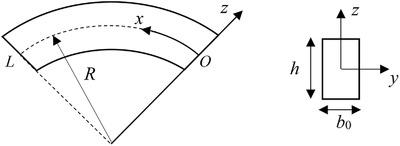Our official English website, www.x-mol.net, welcomes your
feedback! (Note: you will need to create a separate account there.)
Analytical solutions of static bending of curved Timoshenko microbeams using Eringen's two‐phase local/nonlocal integral model
ZAMM - Journal of Applied Mathematics and Mechanics ( IF 2.3 ) Pub Date : 2020-04-18 , DOI: 10.1002/zamm.201900207 Pei Zhang 1 , Hai Qing 1 , Cun‐Fa Gao 1
ZAMM - Journal of Applied Mathematics and Mechanics ( IF 2.3 ) Pub Date : 2020-04-18 , DOI: 10.1002/zamm.201900207 Pei Zhang 1 , Hai Qing 1 , Cun‐Fa Gao 1
Affiliation

|
To eliminate the paradox that Eringen's differential nonlocal model leads to some inconsistencies for the cantilever beams, the original integral nonlocal model restarts to attract a lot of attention. In this paper, Eringen's two‐phase local/nonlocal integral model is utilized to predict the size‐effect on curved Timoshenko microbeams. The governing equations and corresponding boundary conditions are derived via Hamilton's principle. By using the Laplace transform technique and merely adjusting the limit of integrals, the integral constitutive equations are transformed from Fredholm type into Volterra integral equations of the second kind and solved uniquely containing several unknown constants, which are determined through the boundary conditions and extra constrained equations from integral constitutive relationships. The analytical solutions are derived explicitly and are validated against the straight Timoshenko beam for the large‐radius curved case. The results show a consistent softening effect of two nonlocal parameters on the bending behavior of the curved Timoshenko microbeams under different boundary conditions.
中文翻译:

弯曲的Timoshenko微梁静态弯曲的解析解决方案,使用Eringen的两相局部/非局部积分模型
为了消除Eringen的差分非局部模型导致悬臂梁出现某些矛盾的矛盾,原来的积分非局部模型重新开始引起了很多关注。在本文中,Eringen的两阶段局部/非局部积分模型用于预测弯曲的Timoshenko微束的尺寸效应。通过汉密尔顿原理导出控制方程和相应的边界条件。通过使用拉普拉斯变换技术,仅调整积分的极限,积分本构方程就从Fredholm类型转换为第二类的Volterra积分方程,并唯一求解了几个未知常数,这些常数是由边界条件和附加约束方程确定的来自不可分割的本构关系。对于大半径弯曲的情况,解析解是明确导出的,并针对直线Timoshenko梁进行了验证。结果表明,在不同边界条件下,两个非局部参数对弯曲的Timoshenko微梁的弯曲行为具有一致的软化效果。
更新日期:2020-04-18
中文翻译:

弯曲的Timoshenko微梁静态弯曲的解析解决方案,使用Eringen的两相局部/非局部积分模型
为了消除Eringen的差分非局部模型导致悬臂梁出现某些矛盾的矛盾,原来的积分非局部模型重新开始引起了很多关注。在本文中,Eringen的两阶段局部/非局部积分模型用于预测弯曲的Timoshenko微束的尺寸效应。通过汉密尔顿原理导出控制方程和相应的边界条件。通过使用拉普拉斯变换技术,仅调整积分的极限,积分本构方程就从Fredholm类型转换为第二类的Volterra积分方程,并唯一求解了几个未知常数,这些常数是由边界条件和附加约束方程确定的来自不可分割的本构关系。对于大半径弯曲的情况,解析解是明确导出的,并针对直线Timoshenko梁进行了验证。结果表明,在不同边界条件下,两个非局部参数对弯曲的Timoshenko微梁的弯曲行为具有一致的软化效果。











































 京公网安备 11010802027423号
京公网安备 11010802027423号